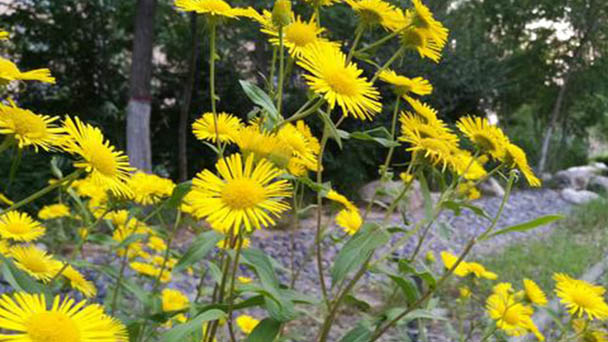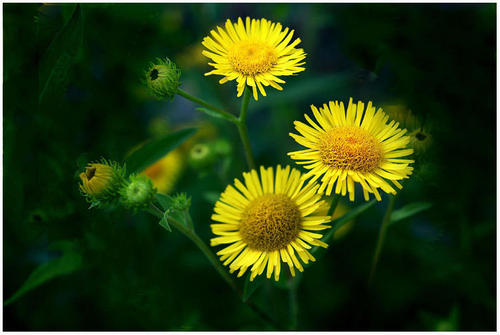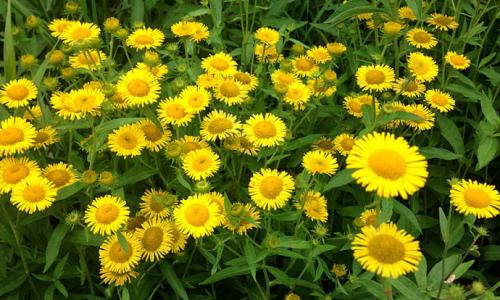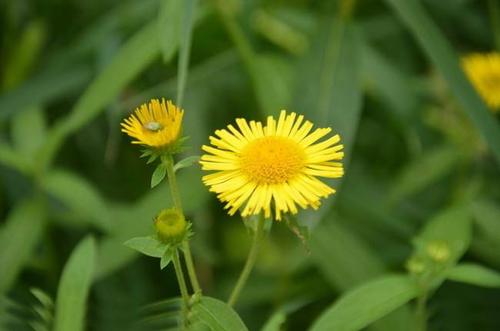Inula Japonica Profile
Written by Maggie
Oct 30 2021

Inula Japonica is a perennial herb of Compositae and Inula Japonica, mainly distributed in Northeast China, North China, East China, Central China and Guangxi.
Inula Japonica Picture

Characteristics of Inula Japonica
Inula Japonica is a perennial herb with short rhizomes, transverse or obliquely ascending and many stout fibrous roots. Stems are solitary, sometimes 2-3 fascicled, erect, 30 -- 70 cm high, sometimes with adventitious roots at base, 3 -- 10 mm in diameter at base, rill, covered with long hairs, or sometimes depilated below, with ascending or spreading branches distally, all with leaves; The internodes of Inula Japonica are 2-4 cm long.
Leaves of Inula Japonica are alternate, elliptic, elliptic lanceolate or narrow long elliptic. Inflorescence head few or many, terminal, was a corymbiform arrangement. Achene is long elliptic, white bristles, white crested hairs.
Basal leaves of Inula Japonica are often smaller, wilted at anthesis; Middle leaves are oblong, oblong-lanceolate or lanceolate, 4-13 cm long, 1.5-3.5 thin 4 cm wide, the base of the number of narrow, often circular semicirculate auricle, sessile, tip slightly pointed or acuminate, the edge of a small pointy head sparsely dentate or the entire margin, above a sparsely hairy or nearly glabrous, below a sparsely overbearing hair and glandular points; Dense long hairs in midvein and lateral veins; Upper leaf of Inula Japonica is tapering, linear-lanceolate.Inflorescences 3-4 cm in diameter, many or few arranged into dispersed corymbs;Peduncle slender.
Involucre of Inula Japonica is hemispherical, 13 -- 17 mm in diameter, 7 -- 8 mm in length; Involucral bracts are ca. 6 layers, linear-lanceolate, subequal, but outermost often leafy and longer; Outer base is leathery, upper leaf leathery, abaxially overlying hairy or subglabrous, ciliate; The inner layer except the green midvein is dry membranous, acuminate, glandular and ciliate. Ligulate flowers of Inula Japonica are yellow, 2-2.5 times longer than the involucre; Tongue linear, 10-13 mm long; Corolla tubular ca. is 5 mm, with triangular lanceolate lobes; Crest 1 layer, white with more than 20 viscose, nearly as long as the tubular flowers. Achene of Inula Japonica is 1-1.2 mm long, cylindrical, with 10 furrows, apex truncate, sparsely short hairy.
Inula Japonica Leaf
Stem of Inula Japonica is longitudinally ribbed, green or slightly purplish red. Leaves are alternate, elliptic, elliptic lanceolate or narrowly long elliptic, 6 ~ 10 cm long, 1 ~ 2.5 cm wide, apex acute, slightly narrow at base, sometimes small ears, semi-branched stem, whole or serrate, green above, sparsely pellucid, light green below, densely pellucid.
Inula Japonica Flowers
Inflorescences have few or many, terminal, corymbiform arrangement, 3 -- 4 cm in diameter; Inflorescence pedicels of Inula Japonica are white-hairy: bracts usually 1-lanceolate near inflorescence, pilose; Involucral bracts are semicircular, 8 -- 10 mm long, 1 -- 1.8 cm in diameter, involucral bracts several layers, outer lanceolate, inner linear-lanceolate or linear, dry membranous, outer hairy or ciliate only; Receptacle is slightly convex; Flowers liguulate 1 layer, yellow, female, corolla apex 3-lobed, base slightly joined on both sides tubular, pistil 1, ovary inferior, angulate, white short bristles, style linear, stigma 2-lobed; Tubular flowers of Inula Japonica are bisexual, at center of inflorescence.
Corolla apex is 5-dentate, lobes ovate-triangular, stamens 5, polymycete, filaments separated and short, pistil 1, style linear, stigma 2-lobed. Achene of Inula Japonica is long elliptic, white bristles, white crested hairs. Inula Japonica was born on hillsides, roads, fields or wetlands near water.
Habits of Inula Japonica
Inula Japonica likes sunlight, has developed roots, and is resistant to diseases and insects, and is resistant to cold, drought and poor soil.
Inula Japonica is born on hillsides, wet grasslands, river banks and ridges at an altitude of 150-2400 m.
How to Grow and Care for Inula Japonica
Inula Japonica is best suited for a warm and humid climate. It grows well in fertile sandy loam or humus loam.
Before sowing, autumn ploughing should be carried out, and base fertilizer should be applied at the same time. The next year in spring again shallow ploughing 1 time, rake bed, bed width 1-1.2m.
When the weather is dry, Inula Japonica should be watered in time. When the topsoil is compacted after hot and dry or heavy rain, it should be loosened in time to reduce moisture evaporation.

How to Propagate Inula Japonica
Inula Japonica Propagation from Seed
First, choose healthy, plump seeds. When the seeds of Inula Japonica are ready, plant the seeds directly on potted soil, cover them with a thin layer of soil, and water them to keep the soil slightly moist.And then put the pot in a cool, ventilated place,
About 10 to 14 days after sowing, the seeds of Inula Japonica will germinate. When the seedlings have 3 to 4 true leaves, seek medical treatment for pot planting. The plants can be transplanted according to the row spacing of 30×15cm.
Inula Japonica Propagation from Division
Planting time of Inula Japonica can be carried out in summer. Florists can dig out the new plants next to the mother plant and keep a little bit in the soil, then divide the newly dug plants into pot seeds. Generally, holes can be opened according to the row spacing of 30×15cm.
Each hole can be planted 2-3 plants, after the cover of soil is compacted, at the same time to water to keep wet.
Species Taxonomy of Inula Japonica
Line leaves Inula Japonica
Leaves Inula Japonica, perennial, 30-60 cm tall, all subglabrous or pubescent. Leaves are alternate, linear-lanceolate residual-linear, 6 -- 12 cm long and 6 -- 12 mm wide, apex acute, base slightly encrusted, margin rebounding, pale green below, pubescent.
Inflorescences are terminal, branched, corymbiform arrangement, 1.5 -- 2 cm in diameter; Bracts are lanceolate; Involucral bracts semicircular, involucral bracts 3-layered, outer lanceolate, inner surface 2-layered linear-lanceolate or linear, smooth or marginally ciliate; Flowers liguate 1-layered, yellow, corolla apex 3-lobed, proximally connected with a synthesized tube, pistil 1-lobed; Tubular flowers apex 5 dentate, stamen 5, pistil 1.
Achene is elliptic, apex shapely, angulate, white sparsely bristled, crested white. It grows on hillsides, roadsides or fields.
Big flower Inula Japonica
Inula Japonica, also known as Inula Japonica.
Herbs are perennial, 20 ~ 60 cm high, all densely covered with fine hairs and white wool. Leaves are alternate, leaves long elliptic or ovate-lanceolate, 4 ~ 10 cm long.1.5 -- 2.5 cm wide, apex acuminate, base cordate, amplicate, entire or slightly serrate, densely strigose below.Inflorescences few, terminal, corymbiform arrangement, inflorescences 3-5 cm in diameter: peduncle densely white woolly or fine hairs; Bracts are lanceolate, hairy: involucral bracts semicircular, 13 -- 22 mm in diameter, involucral bracts 4-layered, outer linear-lanceolate, inner linear-lanceolate, outer densely covered with fine white or woolly hairs;1 layer of liguulate flowers, corolla apex 3 dentate lobes, the base is synthesized tube, pistil 1: tube flower apex 5 lobes, lobes triangular ovate, stamen 5, pistil 1.
Achene is oblong, angulate, white bristles, white crests. It grows in gullies or between the mountains. The roots of the above three plants are also used for medicinal use, and the whole grass is used for medicinal use.
Distribution of Inula Japonica
Inula Japonica is mainly distributed in Mongolia, Russia, Japan, Korea, North, Northeast, Central, East China, Guangdong, Guizhou, Sichuan, Fujian and other regions
Inula Japonica Uses
Potted Plant
Inula Japonica is a yellow flower with yellow stamen. Inula Japonica is very attractive and is commonly used as a potted plant.
Landscape uses
Inula Japonica is commonly used in flower beds, flower borders and bushes.

Latest Updated
- Benefits of Bugleweed - 7 Science-backed Health Benefits
- Bugleweed Dangers & Side Effects - Is It Poisonous?
- How to Plant Evergreen Trees - What You Should Know
- When to Plant Evergreens - Grow Guide for Evergreen Trees
- 12 Wonderful Evergreen Shrubs for Your Garden
- 12 Popular Evergreen Plants with Pictures for Beginners
- When And How To Prune A Lilac Bush Like a Pro
- How to Grow & Care for Lilac Vine (Hardenbergia Violacea)
- Japanese Lilac Tree (Syringa Reticulata) Care & Propagation Guide
- Shumard Oak Pros and Cons - What to Know
Popular Articles
- Winter maintenance of Antirrhinum Majus
- How to Grow Terminalia Mantaly Tree
- How to Grow and Care for Crossostephium Chinense
- How to grow Antirrhinum Majus in spring
- Peristeria Elata (Dove Orchid) Profile: Info & Care Guide
- Underwatered Snake Plant (Sansevieria Trifasciata) - Signs And How To Fix
- How to Care for Brazilian Jasmine Plant (Mandevilla Sanderi)
- How to Grow & Care for Graptopetalum Purple Delight in Summer
- Rosa Chinensis (China Rose): Plant Growing & Care Tips
- How to Care for Baby Sun Rose (Aptenia Cordifolia)